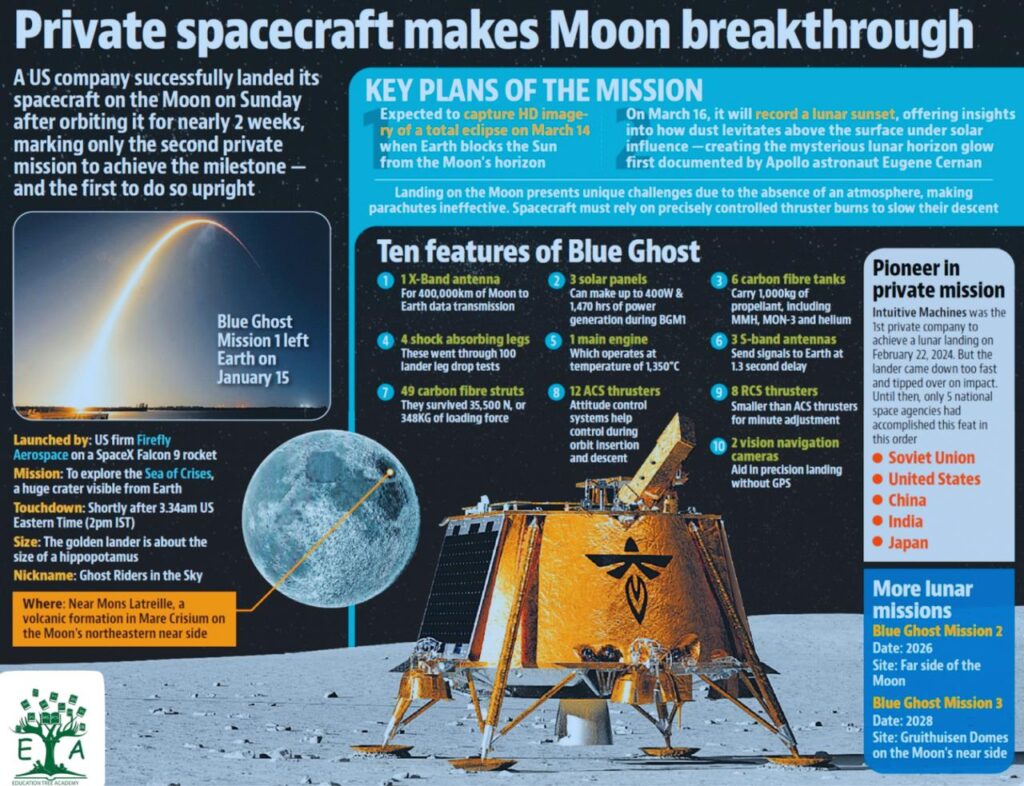WHY IN NEWS?
Firefly Aerospace’s uncrewed lunar lander, Blue Ghost, has achieved a successful soft landing in the Mare Crisium region of the Moon. This accomplishment positions Firefly Aerospace as the second private-sector company in history to achieve this significant milestone.
Mission Title: Firefly’s Blue Ghost Mission 1, titled “Ghost Riders in the Sky,” is part of NASA’s Commercial Lunar Payload Services (CLPS) program.
Initiator: The mission is initiated by Firefly Aerospace, a private aerospace company based in the United States.
Launch Details:
- The mission was launched aboard a SpaceX Falcon 9 rocket on January 15, 2025.
- The soft-landing on the lunar surface is scheduled for March 2, 2025.
Landing Location: The Blue Ghost lander is set to land in Mare Crisium, a significant lunar basin visible from Earth.
Milestones:
- Firefly has become the second private entity to achieve a lunar landing.
- This mission is the first commercial endeavor to successfully perform a soft-landing on the Moon.
Payloads:
- The lander is equipped with 10 scientific and technological payloads, including NASA instruments designed to study lunar dust, radiation, and surface materials.
Mission Duration: The Blue Ghost lander is expected to operate for approximately 14 Earth days, which is equivalent to one lunar day.
Future Plans: Firefly plans two additional Blue Ghost missions in 2026 and 2028.
NASA’s CLPS Initiative: NASA’s CLPS initiative aims to foster scientific exploration on the Moon to enhance our understanding of the lunar environment for the benefit of all.

Significant Private Space Exploration Missions
Axiom Mission:
- Overview: Axiom Space’s mission, a privately funded and operated crewed endeavor, is focused on reaching the International Space Station (ISS). The mission utilized the SpaceX Crew Dragon spacecraft and Falcon 9 rocket, with the launch taking place at NASA’s Kennedy Space Center in Florida.
- Mission Details:
- Axiom Mission 1: The world’s inaugural commercially crewed private spaceflight to the ISS, launched in April 2022, with a mission duration of 17 days.
- Axiom Mission 2: Launched in 2023, the crew spent 8 days in orbit.
- Axiom Mission 3: Scheduled for 2024, with a planned docking period of 18 days.
- Axiom Mission 4: Planned for 2025, with Shubhanshu Shukla, an officer of the Indian Air Force and ISRO astronaut, designated as the pilot.
Polaris Dawn Mission:
- Overview: The Polaris Dawn mission began in September 2024, with a private human spaceflight utilizing the SpaceX Crew Dragon spacecraft and Falcon 9 rocket. Crew Dragon is capable of transporting up to seven astronauts but typically carries four astronauts along with cargo for NASA missions. The Falcon 9 rocket is a reusable two-stage vehicle designed for various space operations.
- Mission Details:
- The mission’s crew of four astronauts spent five days in space.
- They ventured further into space than any humans since the Apollo 17 mission in 1972.
- The mission traversed sections of the Van Allen radiation belt, investigating the health impacts of space radiation on the human body.
- The crew conducted the first commercial spacewalk.
Odysseus Mission:
- Overview: Initiated by the U.S.-based company Intuitive Machines, the Odysseus mission represented the first commercial spacecraft to reach the Moon, achieving this milestone in February 2024.
- Mission Challenges:
- Unfortunately, the mission experienced a hard landing on a lunar crater slope, which caused damage to onboard instruments.
- Despite this setback, the mission highlights the increasing involvement of private companies in space exploration, with NASA and other space agencies relying more on commercial partners to drive scientific and technological advancements in space.
